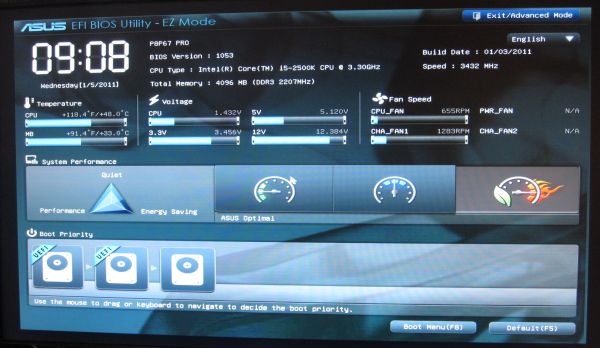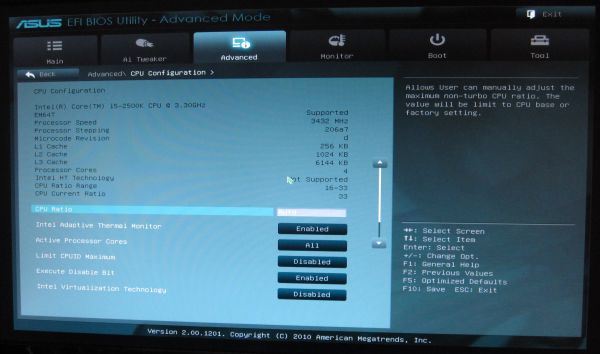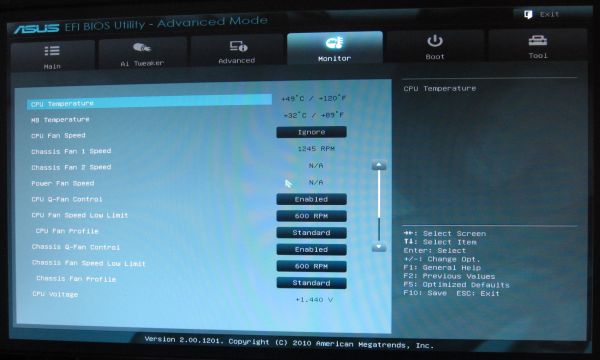The Battle of the P67 Boards - ASUS vs. Gigabyte at $190
by Ian Cutress on January 20, 2011 4:15 PM EST- Posted in
- Motherboards
- Gigabyte
- Asus
- P67
ASUS bring a lot of innovation to the UEFI table over what I have seen from other vendors. The implementation of EZ mode (‘easy’ mode, for us Brits that pronounce that letter ‘zed’) gives the screen below on first entering the UEFI. At a glance, it gives vital motherboard information – CPU, speed, memory, temperatures, voltages, fan speeds, and boot order. The boot order is a great addition, allowing the user to drag-click the order they want. Also available is the three performance options – low power, standard, and performance.
By clicking onto the advanced mode, we get a more BIOS-esque representation of all the motherboard features. The Ai tweaker provides all the overclocking tools we would expect, and more than you find in the Ai Suite in the OS. Features use either a text box for typing values, or a selection box for preset values. The user can utilise the mouse or the keyboard for either task.
Elements such as enhanced sleep states appear under the Advanced CPU Configuration menu, where cores and ratios can be determined. In the Onboard Devices section, if you are not using the Marvell SATA ports, it is advised that this be switched off, to increase boot time by 1-2 seconds.
Fan controls are found in the Monitor tab, where a low limit fan RPM can be given and fan control can be switched between standard/silent/turbo/manual. In manual mode, you can adjust the upper and lower temperature of the fan and at which percentage speed it should run at those temperatures.
Users can specify advanced mode to be shown as soon as the UEFI is selected, and ten UEFI profiles can be saved. The UEFI can also be updated through the Tools tab if the latest file is supplied on a USB drive and plugged in before the ‘update’ option is chosen.
Overclocking
Overclocking on the P8P67 Pro was easy. The UEFI EZ mode offers a performance mode option, which on selecting, enabled the XMP profile of the memory, applied a 103 BCLK, and set the turbo limit to 42x, giving a 4.33 GHz overclock.
As the Ai Suite offers the ‘Auto Tuning’ option, I selected this in the OS and let the program do its thing. After a couple of reboots, and a BSOD, the OS booted into a screen showing a 43x multiplier at 103.5 BCLK (4.45 GHz), and attempted a series of stability tests, slowing increasing the BCLK by 0.5 every 30 seconds. At 105.5 BCLK, a BSOD screen appeared and seemed to crash halfway through, requiring me to reset the system physically. On the next boot, it was stated that the 43x103.5 overclock was applied and now usable. This system is likeable as it promises to adjust depending on how overclockable the processor is.
The downside is that the Ai Suite is quite conservative. I kept with the 103.5 BCLK and went into the UEFI. In advanced mode, adjusting the turbo ratio by one each time and rebooting led to a 46x multiplier (4.76 GHz) successfully passing stability tests. For 47x multiplier (4.86 GHz), I increased the PLL to 1.9V, CPU VCore to 1.42 V, and adjusted the short/long power limits to 150 W/130 W to get a successful stability test pass. This automatically set the memory to a command rate of 3T, so was set back to 1T manually. The 48x multiplier did not boot at this level, and I was not prepared to up the VCore or power limits any more. A 4.86 GHz overclock is very respectable!
At 4.86 GHz (47% OC over 3.3 GHz/non turbo/multithreaded, 31% OC over 3.7 GHz/turbo/single-threaded), the 3D Movement benchmark was run. In single thread mode, a score of 148.92 was achieved, a 31% increase. In multi-threaded mode, a score of 477.60 was achieved, a 37% increase.




















137 Comments
View All Comments
7Enigma - Tuesday, January 25, 2011 - link
And in my experience I'm on the exact opposite. Built a gaming computer for my dad last summer. Started to randomly refuse to turn on after 2 months of use normal. After ruling out peripherals I pulled the HSF off and popped the CPU out to see a DISCONNECTED PIN on the mobo! Just sitting there on the ground like it had decided to fall off. Contacted Gigabyte through Newegg and received NO response. TONS of people were having similar issues both on their forums and on Newegg. I never received a response from them and ended up shelving the $130 mobo in my basement and buying a $140 Asus which has been rock-solid since installation last fall.Prior to this lack of customer support I was a huge fan of Gigabyte. My last 2 mobo's and video card were from them and I had nothing but praise when asked for a recommendation by friends/family. After the mobo fiasco and clearly being ignored (both myself and other enthusiasts) I've sworn off the company.
Makaveli - Thursday, January 20, 2011 - link
was that 920 D0 at stock speeds for the gaming test or overclocked?MeanBruce - Thursday, January 20, 2011 - link
Really feel it's worth waiting for the SandyBridge E LGA-2011 Asus Rampage IV Extreme X68 with Quad memory. That mobo will last through Ivy Bridge 22nm and maybe even into Haskins! In the meantime think I'll drive over to motor city and pick up some new rocks.vol7ron - Thursday, January 20, 2011 - link
Mmmm quad mem.Gothmoth - Thursday, January 20, 2011 - link
honest the H67 and P67 boards, as good as they are, are only to suck the money from the dumb enthusiasts who will not wait for the REAL DEAL.im not buying this stuff from, intel im waiting for Z68.
this overclocking/quick sync sillyness with the current chipsets really sux.
don´t know what intel is thinking but im not buying this crap thats for sure.
vol7ron - Thursday, January 20, 2011 - link
Second. It's actually a good marketing move to get rid of old partsMeanBruce - Thursday, January 20, 2011 - link
Mmmm Z68...strikeback03 - Friday, January 21, 2011 - link
Well, for some users the current offerings do make sense. If you are building a pure gaming system P67 shouldn't limit you any, as QuickSync isn't likely to be that important to you. Or our work computers, for example, will never be overclocked, so H67 boards would be fine for that use.That said, any mild enthusiast building some form of general-purpose system should probably wait for Z68. Dunno how Intel screwed that up, but it was dumb.
7Enigma - Tuesday, January 25, 2011 - link
Here here. I'll read the reviews for Anandtech but wouldn't touch this junk with a 10 foot pole. All the mobo manufacturers should be ticked at Intel for pulling this stunt as it doesn't affect them, just us as the end users and the mobo companies.GoodBytes - Thursday, January 20, 2011 - link
I agree with Beenthere.Since 2003-04 I notice ASUS cut on quality like no tomorrow. And their RMA service (well at least in Canada) is non-existant. Staff are rude, don't want to work, takes a month to process a replacement (this is NOT one of those once in a life time experience, this happened to me twice, and friends), and you get at the end someone else RMA'ed board with a different problem and packed with dust. When I got that as a second time, now they draw the line. I switch to Gigabyte. The boards feel quality over ASUS high-end boards, and unlike ASUS boards, they don't break soon after the warranty.
So yes, Gigabyte boards are more expensive for what you get in term of features, but in terms of life span and quality, Gigabyte wins by far. And I used to be a ASUS-fan, hence why I closed my eyes on my first bad experience, and the ones of my friends. Idiot I was.
When Gigabyte said that ASUS boards where crap.. they were not kidding... When that was said I was like most people "Pfff what are they talking about"... and now I see how crappy the boards are.
I really don't get what's so special about ASUS, and I am tiered of reviews who ignore quality and long term usability. Did the reviewer tested the computer to go into sleep, and hibernate several time in a row, and long period of sleep for a week, to see if the board wake up, and that EVERYTHING is fully function (every USB, Ethernet port(s) and eSATA (if any))? Does the review test the board under stress for really long time. How about leaving the computer turned on for a week, no reboot, how many time if failed (if any). How about heat dispersion, to ensure that the board can last longer over 3 years in a state of being overclocked. All this is ignored by all review sites... They all cover the same things... performance, warranty by years (and not actually SEEING how the server is, and the time it takes for a replacement), how it overclocks, and features numbers.
These are the moment where I wish that if I had more time, I would collect resources and start my own review site. But the problem is I am already anti-ASUS... so I can't even be legitimate.